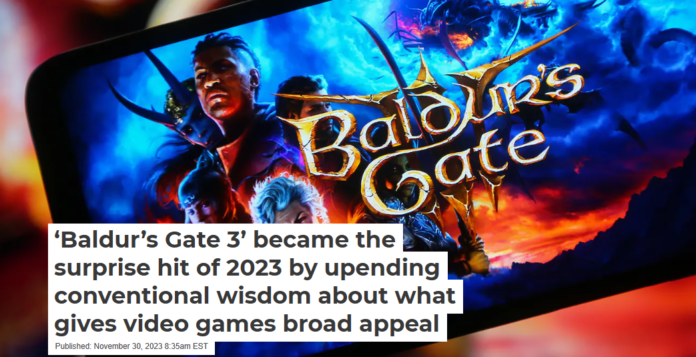

James Dawes, Macalester College
Few predicted that the smash hit video game of 2023 would feature old-school game mechanics, hours of brooding cutscenes and a vexing learning curve.
Yet “Baldur’s Gate 3,” a 20-year-old title based on a 50-year-old role-playing game, has already become one of the highest-rated video games of all time.
“This is a very specific niche of game,” admitted Swen Vincke, the CEO of Larian, its developer. “We’ve never been about the money.”
Nonetheless, since Larian released the title in August 2023, the company has been raking in the money. And it has done this with a rare focus on elements like story and character, upending the industry’s conventional wisdom about what it takes to create a blockbuster game.
Going against the grain
“Baldur’s Gate 3” was underestimated, in large part, because it is old-fashioned.
It’s based on the oldest role-playing game around, Dungeons & Dragons. It features an out-of-style combat system and a gobsmacking 174 hours of narrative cutscenes, which are akin to mini-film clips – and are generally considered passé because they interrupt gameplay.
Even more off-putting: There’s a steep learning curve, which harks back to the bygone days of the arcade, when games were designed not to sustain engagement but to present a challenge – and extract as many quarters from players as possible.
Despite all of this, “Baldur’s Gate 3” captured more than 25% of all playtime on the gaming distribution platform Steam during the first weekend of its release, with gamers logging an astonishing 10 million hours.

Narrative gets a much-needed win
To understand why teachers of game design like me are so excited about “Baldur’s Gate 3,” it’s helpful to focus on a concept we use in game studies: namely, the continuum between narratology and ludology.
Narratology prioritizes the storytelling aspect of video games, whereas ludology – from the Latin “ludus,” or game – prioritizes gameplay and game mechanics.
“Tetris” was pure gameplay, all geometry and timing, while the earlier, text-based adventure “Zork” was pure interactive storytelling.
Most games involve both, but the narrative is almost always secondary. The thinking goes that you can have a good game without a good story, but you can’t have a good game today without good gameplay.
Moreover, the kind of story you can tell is limited by the kind of game you are designing. If you want to write a poignant little tale about somebody who really just needs a hug, you can’t do it with gameplay defined by hacking evildoers to death with a hatchet. https://www.youtube.com/embed/ToEllOW2r1Y?wmode=transparent&start=0 A brief history of ‘Zork,’ a game that’s entirely centered on text and storytelling.
What distinguishes “Baldur’s Gate 3” from the vast majority of games is that it is, at its heart, a narrative game. Players can spend hours clicking through dialogue options to trigger chatty cutscenes that flesh out backstories and advance character plots. They can flirt with a fiery barbarian devil, confront the racial prejudice of an extraplanar visitor, or help the emo priestess Shadowheart process her childhood trauma.
One of its most dramatic and memorable moments – spoiler alert – is when players get to give a hug to somebody who desperately needs one, even though the gameplay is defined by hacking evildoers to death with a hatchet.
These moments – romancing, arguing, befriending, understanding – are the connective tissue that gives form and meaning to the otherwise skeletal mechanics of hacking and slashing.
To ludologists, however, these kinds of cinematics are a design failure. They interrupt the game. They force players to stop playing and start watching. They lazily mimic what novels and films are better at doing.
Ludologists take the writing principle “Don’t tell, show!” and supercharge it for games to “Don’t show, play!”
Leaving money on the table
But the risks “Baldur’s Gate 3” took by leaning into the story go far beyond the doomspeak of ludologists. The gaming industry has shifted away from narrative in recent years as it has evolved from a niche entertainment into a force to rival Hollywood.
As video game journalist Ben Kuchera explained, “Writing doesn’t translate into dollars.”
Why is narrative seen as a bad bet for game studios? And why did Larian decide to make that bet anyway?
The first argument is that narrative has a low – even negative – return on investment. Larian invested heavily to develop multiple side plots and branching narrative pathways, showcasing 276 mesmerizing voice actors and devising a reported 17,000 variations of the ending.
Because choosing one path means closing off another, most players will never experience the vast majority of this carefully wrought content. You can replay the game, but with standard runs taking an estimated 75 hours, even hard-core gamers will still miss out.
And Larian will too. Larian does not make money on player retries. From a financial perspective, undiscovered content represents pure loss.
A narratologist, however, would argue that this kind of “loss” is precisely the point. In “Baldur’s Gate 3,” choices have costs. You can make decisions you will regret. And that is why you can also experience regret’s opposite: delight.
The second argument against narrative game design is structural. Narrative games leave money on the table because they are designed to end. “Baldur’s Gate 3” is structured as a three-act plot with an inciting incident, escalating action, and an appalling and beautiful climax. It leaves players satisfied. And that’s precisely the problem.
The games that make the most money today are designed to never end. Narratively shallow games, such as the first-person shooter “Fortnite,” can keep a player hooked for years, inducing them to spend money on microtransactions that far exceed the one-time purchase price of a game like “Baldur’s Gate 3.” They are desire treadmills, always holding off the promise of satisfaction with the lure of another thing to buy: next season’s loot boxes, next season’s battle pass rewards, next season’s skins. They transform play into shopping.
“Baldur’s Gate 3” has none of this.
“We believe in providing a complete and immersive gaming experience without the need for additional purchases,” Larian wrote on the game’s website.
Gamers and reviewers reacted to that announcement like swimmers taking their first snatch of air after an overly aggressive dunking at a pool party.
Beyond button-mashing
The third argument against story-driven games is that they don’t appeal to a broad audience. The thinking goes that most gamers tend to be hyperactive button-mashers who lack the attention span for complex stories. And because developers can spend tens, even hundreds of millions to bring a game to market, they cannot risk limiting their appeal, so they instead follow established models of success.
Even before the ascendance of the “Fornite” business model, that often meant shying away from story. In a 2007 interview, game designer and producer Warren Spector griped: “You don’t want to know how many projects I’ve been told to ‘just go make a shooter.’ I had one publisher tell me ‘you’re not allowed to say story anymore.’ It’s a constant battle to do something other than what everyone else is already doing.”
For now, the gaming industry has dubbed “Baldur’s Gate 3” a unicorn to admire rather than a model to follow. Larian can do what others cannot because it is a privately owned company that doesn’t have to compromise artistic choices due to financial pressures.
That may be true. But the game’s surprising success is a much-needed reminder that in the video game industry, making art and making money aren’t mutually exclusive.
James Dawes, Professor of English, Macalester College
This article is republished from The Conversation under a Creative Commons license. Read the original article.



















